Facilities
Overview
The Plasma Elemental Analysis CorE Lab, located on the first floor of the Molecular Biology building (MBB 1.318), is a five-room complex with positive pressure gradients across rooms such that the Clean Lab > Instrument Bay > Chiller Room, Anteroom, Office > external hallway. The Clean Lab and Instrument Bay have in-ceiling HEPA-filtered supply air. All rooms have fiberglass-vinyl latex ceiling tiles to minimize particulates. Street shoes are changed to lab shoes in the anteroom before working in the Instrument Bay and/or Clean Lab.
Chiller/Liquid Ar Room
The “Chiller Room” contains chillers and liquid argon dewars (2) for the two ICP-MS/MS instruments, as well as storage space and tools. The liquid Ar dewars have a gas manifold, allowing for the removal or addition of a dewar without interrupting Ar flow to either of the ICP-MS/MS instruments. The room has an independent cooling system to maintain constant room temperature while one or both chillers are on. Chillers are remotely controlled by the ICP-MS software. The chiller/liquid Ar room is sound-proofed making for a quiet surrounding lab complex.
Instrument Bay
The Instrument Bay contains two Agilent 8900 ICP-MS/MS instruments with optional laser ablation systems for LA-ICP-MS and intelligent autodilution/autocalibration systems for solution mode ICP-MS. The 8900 instruments are housed on mobile benches containing sound-dampened cabinets for roughing pumps. The “roughing pumps” are dry scroll pumps that provide oil-free, sustainable, and quite vacuum. The bay is configured with an AV system and large central table for teaching of small classes, presentations, and short courses.
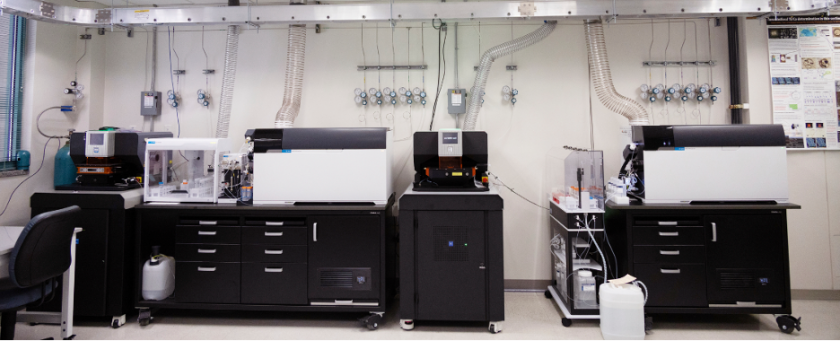
Agilent 8900 ICP-MS/MS Instruments

The Agilent 8900 ICP-MS/MS instruments use a tandem mass spectrometry configuration consisting of two quadrupole mass filters (Q1 and Q2), separated by a collision/reaction cell (Agilent’s Octople Reaction System, or ORS). Ions filtered from Q1 enter the ORS and interact with a collision gas (He) or specific reaction gases (H2, O2, NH3/He). These interactions either remove the interference, allowing for on-mass analyte measurement on Q2, or result in the production of an analyte-product ion that can be measured by mass-shift on Q2. This configuration allows for ion detection over 11 orders of dynamic range (100s of ppm to ppq) and exceptional removal of complex spectral interferences, including isobaric interferences. For solution mode ICP-MS, both Agilent 8900s have Ultra High Matrix Introduction (UHMI) technology. The UHMI uses clean Ar to dilute the aerosol received from the spray chamber to (1) extend the matrix tolerance to percent levels (up to 25%, depending on the matrix) of dissolved solids; (2) improve plasma robustness to minimize matrix suppression; (3) reduce oxide interferences (to ~0.25% CeO/Ce); and (4) reduce or eliminate the need for liquid dilution of high-matrix samples before analysis. For fast time-resolved analysis by LA-ICP-MS, analyte integration times as short as 0.1 ms can be set.

Intelligent Dilution Systems
ESI prepFAST M5 with Sample Sense
8900 system #1 is equipped with an ESI prepFAST M5 automated dilution system that enables high-precision dilution and/or calibration, thereby improving accuracy, reducing errors, and increasing sample throughput over conventional peri-pumped autosamplers. The system is constructed from chemically resistant fluoropolymer components (PFA valves, tubing, nebulizer) suitable for a wide range of sample matrices. Samples/standards are vacuum loaded into an initial loop, then moved to a second loop while Internal standard is automatically added. If the sample/standard needs dilution (≤400x), dilution via automated addition of a same matrix diluent is also performed during loading of the second loop. The second loop in syringe injected, reducing RSD associated with flicker noise in conventional peristaltic pumps. The prepFAST M5 has integrated optical sensor (SampleSense) technology that optimize the liquid sample introduction process by automatically detecting when samples have been loaded, adjusting sample uptake rate for varying sample viscosities, triggering data acquisition, minimizing sample consumption, and logging failed loading events. The system incorporates reactive logic and automatically dilutes and reanalyzes samples with analyte concentrations outside of the calibration range.
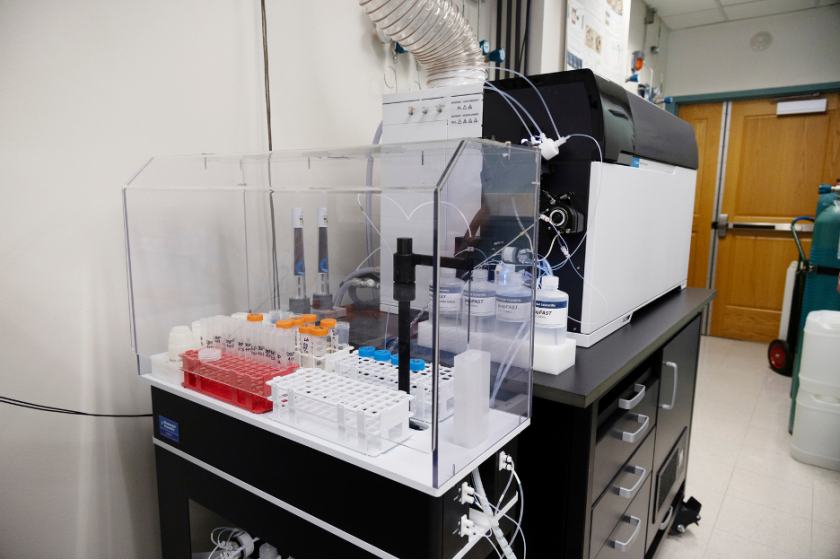
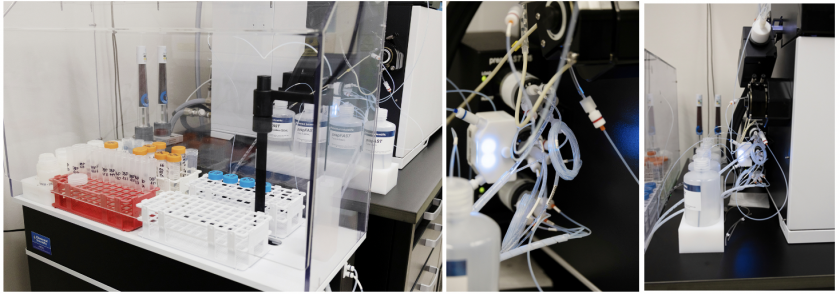
Agilent ADS-2
8900 system #2 is equipped with Agilent’s ADS-2 (Advanced Dilution System 2) intelligent autodilution system. The ADS-2 offers similar benefits to the prepFAST M5 described above. It performs dilutions from 2-400x, automatically adds internal standard, can prepare multi-point calibration standards from a single stock solution, can auto dilute and reanalyze over range samples, and can remeasure samples having internal standard failures. The system operates using two syringes (carrier, diluent) for high accuracy and precision. Samples not requiring dilution bypass the diluter, minimizing analysis time and maximizing efficiency.
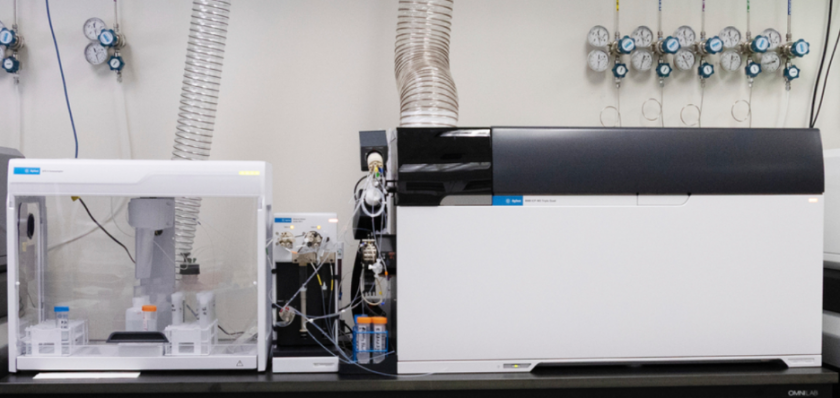

Laser Ablation Systems
Both laser systems (see below) use ultrapure He as the cell gas and ultrapure N2 to purge the optical paths of the lasers. Both gases are controlled by a manifold system that allows for continuous LA-ICP-MS operation while a gas cylinder is replaced and brought online. A dedicated laminar flow workstation is used for clean sample loading of ablation cells. The lab has a wide range of certified microanalytical reference materials suitable for hard and soft rock analysis. LA-ICP-MS data reduction using iolite4 is available on three computer workstations. ESI ActiveView2 is the LA-ICP-MS software.
ESI NWR193uc
The ESI NWR193uc is an ArF excimer laser system operating at a wavelength of 193nm with a short pulse width (4-6ns) that provides high peak power for efficient ablation of various materials (geology, anthropology, material science, biology, forensics) for trace element analysis, isotope ratio determinations, and elemental mapping. It is equipped with ESI’s large format (15×15 cm) TwoVol2 (Two Volume Two Cell) ablation cell with fast washout (0.7s) that often enables single loading of complete or multiple study sets and standards. The cell design obtains consistent gas flow patterns and reduces aerosol dispersion in the inner analytical cup, increasing signal stability and reproducibility regardless of position within the cell. Fast washout is particularly important for high-resolution elemental mapping, and it can be further decreased using ESI’s Dual Concentric Injector (DCI) device. System features include infinitely variable apertures (IVA) and rotating shutters (XYR) allowing for customized spot sizes (1-150µm) and rectangular apertures. The Rugged Universal Compact Cart (RUUC) design allows the system to be moved between Agilent 8900 #1 and Agilent 8900 #2 systems.
ESI imageGEO 193
The ESI imageGEO 193 is a specialized laser ablation system engineered for high-resolution geochemical imaging at high speeds. It uses the same pulsed 193 ArF excimer source as the ESI NWR193uc system, but offers repetition rates up to 500 Hz, offers customizable spot sizes and shapes up to 150µm in dimension (IVA, XYR). The system is equipped with ESI’s TwoVol3 ablation cell (10x10cm XY stage), capable of 10nm spatial reproducibility, and Dual Concentric Injector (DCI) for ultrafast washouts (<1 ms). By swapping internal cups (< 5 min), the system can be operated in Imaging Mode for fast imaging or Analytical Mode for elemental and isotopic ratio analysis with stable signal intensities (< 1.5% RSD). Imaging Mode uses a fixed direct-to-ICP aerosol path for enabling high-speed, high-resolution (peak widths typically < 1ms) elemental imaging with minimal interpixel smearing. Analytical Mode operates with peak widths of ~700ms providing stable and reproducible peaks accurate and consistent trace element measurements.
Presentations/Teaching
The Instrument Bay has an AV system (ceiling projector, automatic screen, in-ceiling speakers) for presentations and teaching of small classes. Monitor-mirroring allows the same image to be seen on four three different computers, in addition to projected image.
Clean Lab
Adjacent to the Instrument Bay is the Clean Lab, which is routinely used for gravimetric sample dilutions and making of calibrations and quality control standards. The lab is maintained at positive pressure with HEPA-filtered supply air and was designed to minimize contamination. Casework, including the ventilation hood, are all non-metallic. Lab acids are prepared from trace metal grade reagents and densities determined by pycnometer. Calibration standards are prepared from certified reference materials. Quality control standards are prepared or obtained from sources independent of calibration standards.
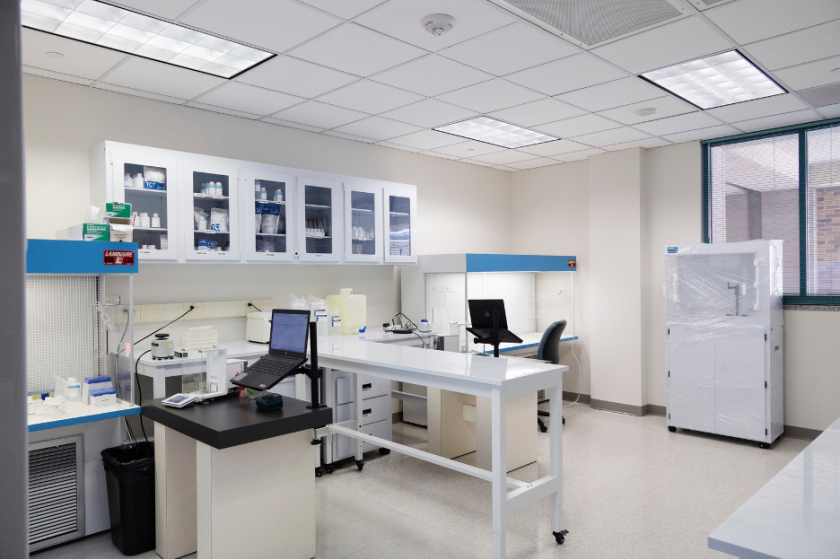




The lab features two comparably equipped (Eppendorf pipettes, pipette tips, matrix reagents) laminar flow workstations with 5-place analytical balances on weighing tables. The balances are interfaced to laptops, allowing stable balance readings (masses) to be accurately recorded in spreadsheets by pushing a button on the balance.

A Milli-Q EQ 7000 water purification system, with Evoqua prefilter, supplies ultrapure Type 1 (18.2 MOhm resistivity, TOC ≤ 5 ppb) water. The Q-POD dispenser has three manually adjustable flow rates (up to 2L/min) and offers one-touch volumetric dispensing (100mL to 25L).
Closed vessel acid digestion of carbonates can be performed, using a sample rotator and 36-position microcentrifuge. Digestion of biological samples, silicate and aluminosilicate materials, are not performed in the lab. Non-HF acid digests (HNO3, HCl, aqua regia) can be brought or sent to the lab for ICP-MS dilution.
seaFAST S2
An ESI seaFAST S2 preconcentration sample preparation system is housed in the clean lab. The seaFAST S2 is designed for ultratrace determination of elements in high-matrix samples such as seawater, marine porewaters, and produced oil-field brines, and thus is of benefit for oceanographic, environmental, and critical element research. The system automates preconcentration and matrix removal to obtain very low detection limits (sub-ppt to pg/L). For preconcentration, undiluted samples are loaded onto a chelation column which binds target transition metals and rare earth elements, while high matrix ions (Na+, Cl-, Ca2+, Mg2+) are rinsed to waste. Concentrated analytes are then eluted in acid (typically HNO3), and the column regenerated for the next sample. Turnaround times are on the order of 5 minutes. The processed concentrated samples are then analyzed by ICP-MS/MS. By eliminating matrix interferences, sensitivity and detection limits are greatly improved. Most non-chelated elements can be analyzed by online dilution using either the prepFAST M5 or Agilent ADS-2 dilution systems.